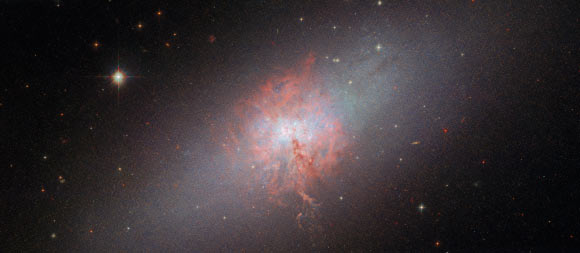Astronomers using the NASA/ESA Hubble Space Telescope have produced two outstanding images of NGC 5253, which is considered a dwarf starburst galaxy and also a blue compact dwarf galaxy.
This Hubble image shows NGC 5253, a blue compact dwarf galaxy some 11 million light-years away in the constellation of Centaurus. Image credit: NASA / ESA / Hubble / A. Zezas / D. Calzetti.
NGC 5253 is located around 11 million light-years away from Earth in the constellation of Centaurus.
Also known as ESO 445-4, IRAS 13370-3123, LEDA 48334 and UGCA 369, this galaxy was discovered by the German-born British astronomer William Herschel on March 15, 1787.
The galaxy is considered part of the Centaurus A/Messier 83 group of galaxies, which includes the famous radio galaxy Centaurus A and the spiral galaxy Messier 83.
The first new image of NGC 5253 is made up of observations from with Hubble’s Advanced Camera for Surveys (ACS), using its Wide Field Channel, and Wide Field and Planetary Camera 2 (WFPC2).
The second image is made using data from the High Resolution Channel (HRC) of the ACS instrument.
This Hubble image depicts NGC 5253, as seen by the High Resolution Channel (HRC) of Hubble’s Advanced Camera for Surveys (ACS). Image credit: NASA / ESA / Hubble / W.D. Vacca.
“What has interested us so much about this galaxy that three of Hubble’s instruments were used to study it in depth over ten years?” the Hubble astronomers said.
“It turns out to lie at the focus of a few areas of research where Hubble’s capabilities are essential.”
“Dwarf galaxies are considered important for understanding the evolution of both stars and galaxies through time, since they resemble ancient, distant galaxies.”
“NGC 5253 is called both a starburst galaxy and a blue compact dwarf: these names mean it is forming clusters of bright, massive stars at an exceptional rate.”
“This Hubble image clearly shows the dense nebula which is being consumed to birth these stars, and which makes NGC 5253 a laboratory to investigate stellar composition, star formation and star clusters, all at once.”
“A tremendously high rate of star formation is a recipe for star clusters, but NGC 5253 goes beyond that: in a small region of the core, the star formation is so intense that the galaxy contains no less than three super star clusters.”
“Super star clusters are very bright, populous and massive open clusters which are believed to evolve into globular clusters,” they said.
“Globular clusters themselves offer unique insights into how stars form and evolve, but their origins are poorly understood.”
“We were therefore eager to make use of the HRC sub-instrument, with its superb resolution, to hone in on these small, very dense clusters of stars.”






































































